Quantitative Finance: Statistical Analysis, CI, and Portfolio Report
VerifiedAdded on 2023/01/19
|23
|4103
|26
Report
AI Summary
This report presents a comprehensive analysis of quantitative finance, focusing on the application of statistical tools in financial markets. The research includes regression analysis, confidence interval calculations, and correlation analysis to identify relationships between variables. The report also addresses data quality and the selection of appropriate statistical tools. Furthermore, it explores portfolio return and standard deviation, identifying portfolios with optimal risk-return profiles. The study covers various aspects of financial data analysis, providing insights into market trends and investment strategies. The report includes tables, charts and graphs to illustrate the analysis and findings. It also includes t-tests and ANOVA tests to identify significant differences between groups and variables. The conclusion summarizes the key findings and their implications for financial decision-making.
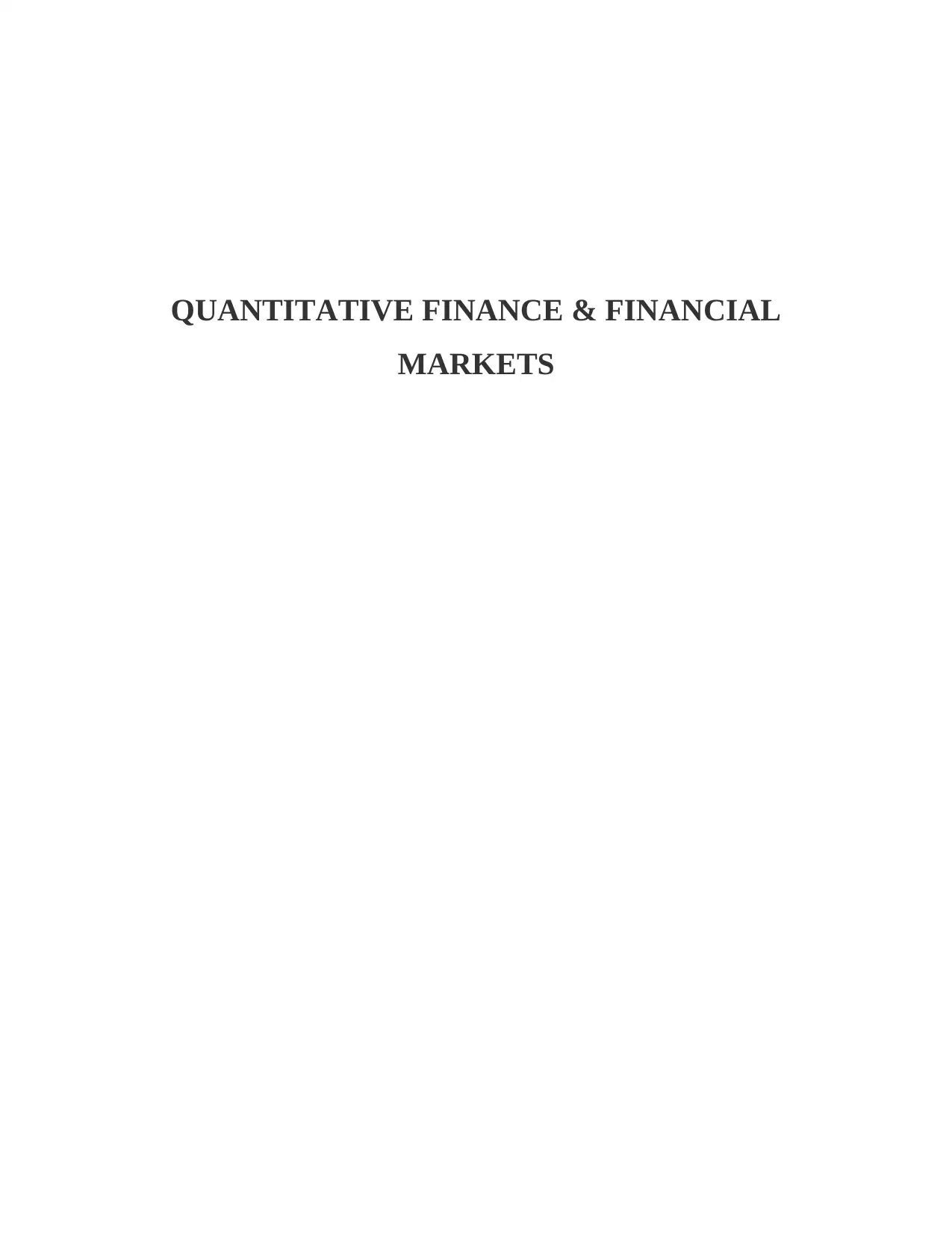
QUANTITATIVE FINANCE & FINANCIAL
MARKETS
MARKETS
Paraphrase This Document
Need a fresh take? Get an instant paraphrase of this document with our AI Paraphraser
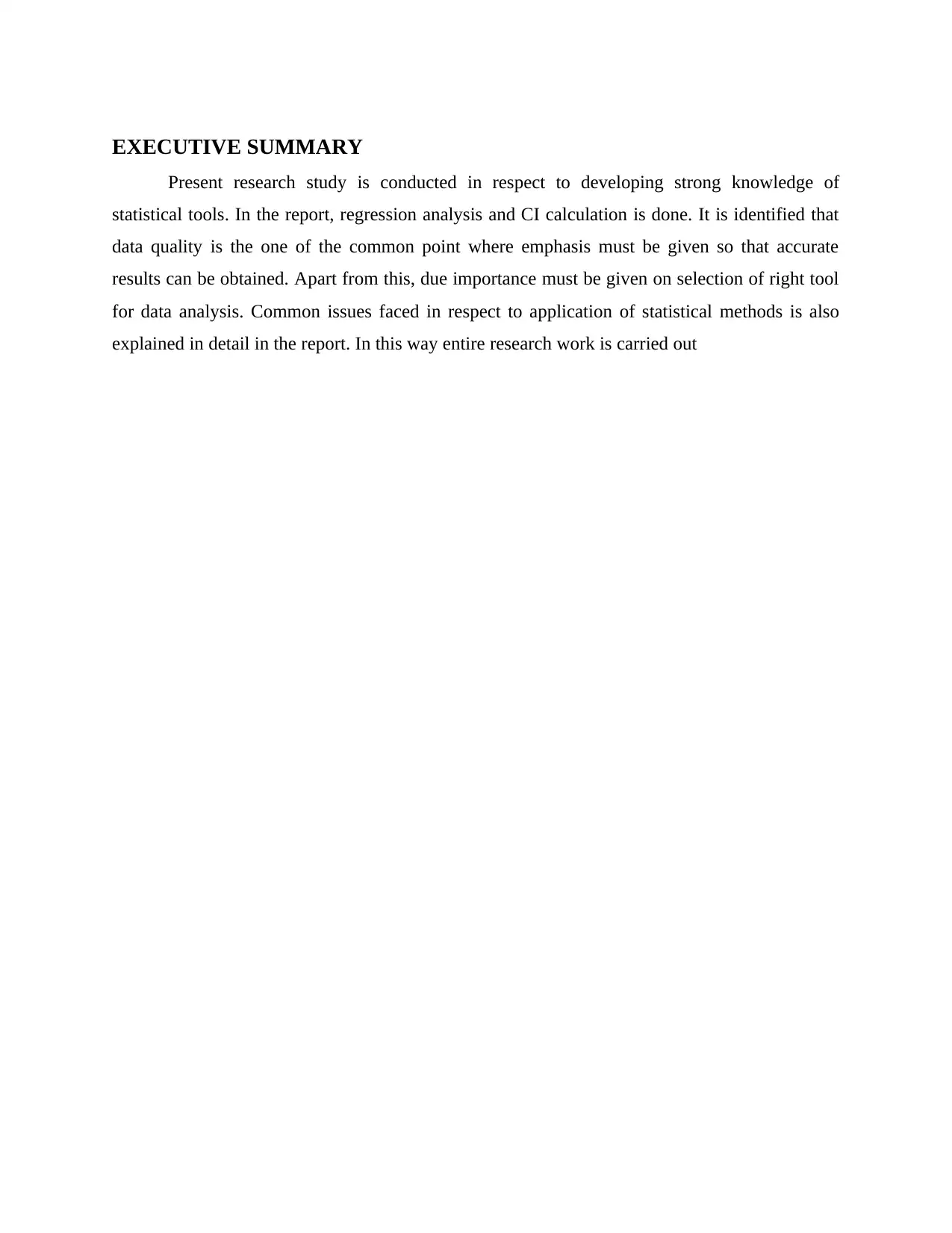
EXECUTIVE SUMMARY
Present research study is conducted in respect to developing strong knowledge of
statistical tools. In the report, regression analysis and CI calculation is done. It is identified that
data quality is the one of the common point where emphasis must be given so that accurate
results can be obtained. Apart from this, due importance must be given on selection of right tool
for data analysis. Common issues faced in respect to application of statistical methods is also
explained in detail in the report. In this way entire research work is carried out
Present research study is conducted in respect to developing strong knowledge of
statistical tools. In the report, regression analysis and CI calculation is done. It is identified that
data quality is the one of the common point where emphasis must be given so that accurate
results can be obtained. Apart from this, due importance must be given on selection of right tool
for data analysis. Common issues faced in respect to application of statistical methods is also
explained in detail in the report. In this way entire research work is carried out
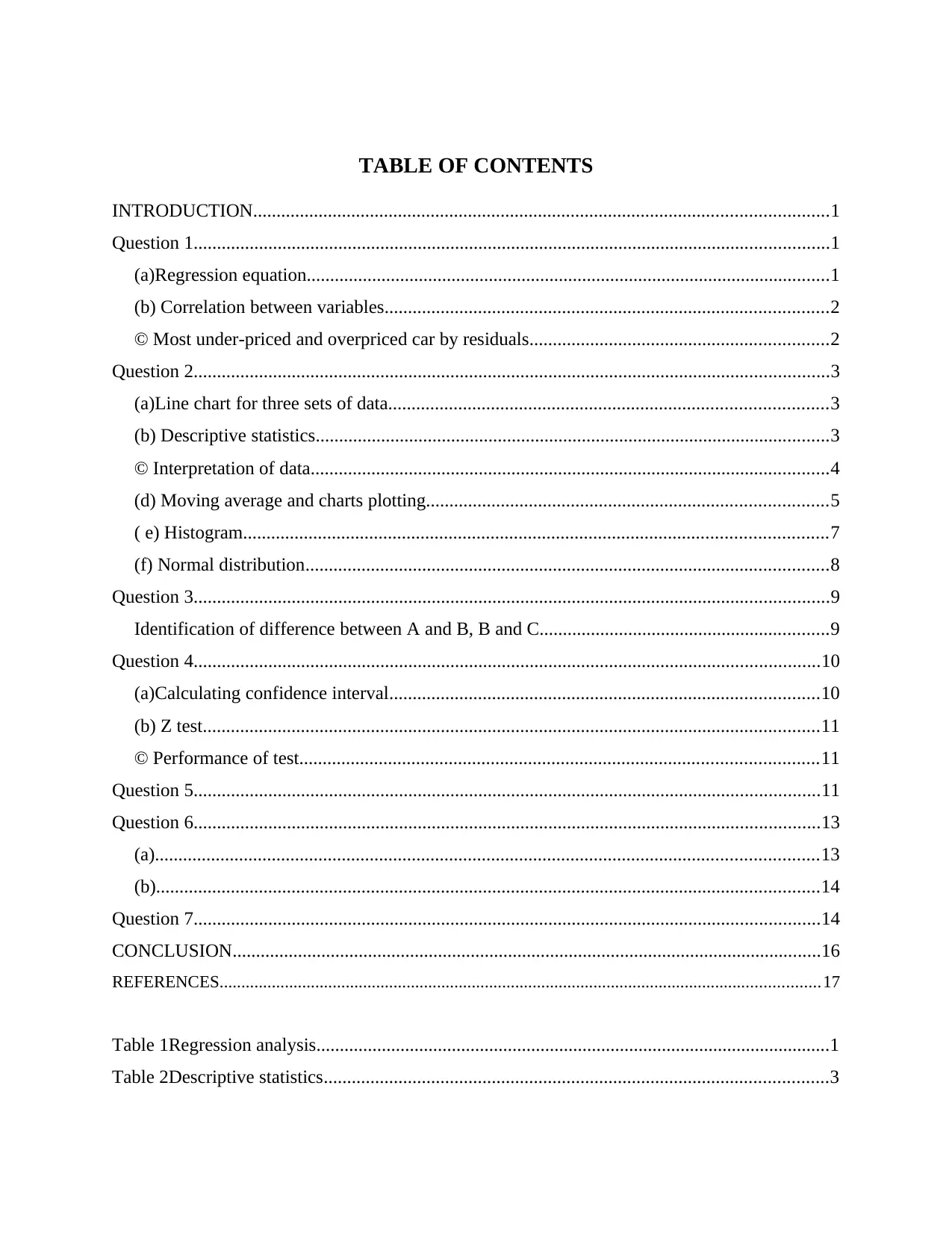
TABLE OF CONTENTS
INTRODUCTION...........................................................................................................................1
Question 1........................................................................................................................................1
(a)Regression equation................................................................................................................1
(b) Correlation between variables...............................................................................................2
© Most under-priced and overpriced car by residuals................................................................2
Question 2........................................................................................................................................3
(a)Line chart for three sets of data..............................................................................................3
(b) Descriptive statistics..............................................................................................................3
© Interpretation of data...............................................................................................................4
(d) Moving average and charts plotting......................................................................................5
( e) Histogram.............................................................................................................................7
(f) Normal distribution................................................................................................................8
Question 3........................................................................................................................................9
Identification of difference between A and B, B and C..............................................................9
Question 4......................................................................................................................................10
(a)Calculating confidence interval............................................................................................10
(b) Z test....................................................................................................................................11
© Performance of test...............................................................................................................11
Question 5......................................................................................................................................11
Question 6......................................................................................................................................13
(a)..............................................................................................................................................13
(b)..............................................................................................................................................14
Question 7......................................................................................................................................14
CONCLUSION..............................................................................................................................16
REFERENCES..........................................................................................................................................17
Table 1Regression analysis..............................................................................................................1
Table 2Descriptive statistics............................................................................................................3
INTRODUCTION...........................................................................................................................1
Question 1........................................................................................................................................1
(a)Regression equation................................................................................................................1
(b) Correlation between variables...............................................................................................2
© Most under-priced and overpriced car by residuals................................................................2
Question 2........................................................................................................................................3
(a)Line chart for three sets of data..............................................................................................3
(b) Descriptive statistics..............................................................................................................3
© Interpretation of data...............................................................................................................4
(d) Moving average and charts plotting......................................................................................5
( e) Histogram.............................................................................................................................7
(f) Normal distribution................................................................................................................8
Question 3........................................................................................................................................9
Identification of difference between A and B, B and C..............................................................9
Question 4......................................................................................................................................10
(a)Calculating confidence interval............................................................................................10
(b) Z test....................................................................................................................................11
© Performance of test...............................................................................................................11
Question 5......................................................................................................................................11
Question 6......................................................................................................................................13
(a)..............................................................................................................................................13
(b)..............................................................................................................................................14
Question 7......................................................................................................................................14
CONCLUSION..............................................................................................................................16
REFERENCES..........................................................................................................................................17
Table 1Regression analysis..............................................................................................................1
Table 2Descriptive statistics............................................................................................................3
⊘ This is a preview!⊘
Do you want full access?
Subscribe today to unlock all pages.

Trusted by 1+ million students worldwide
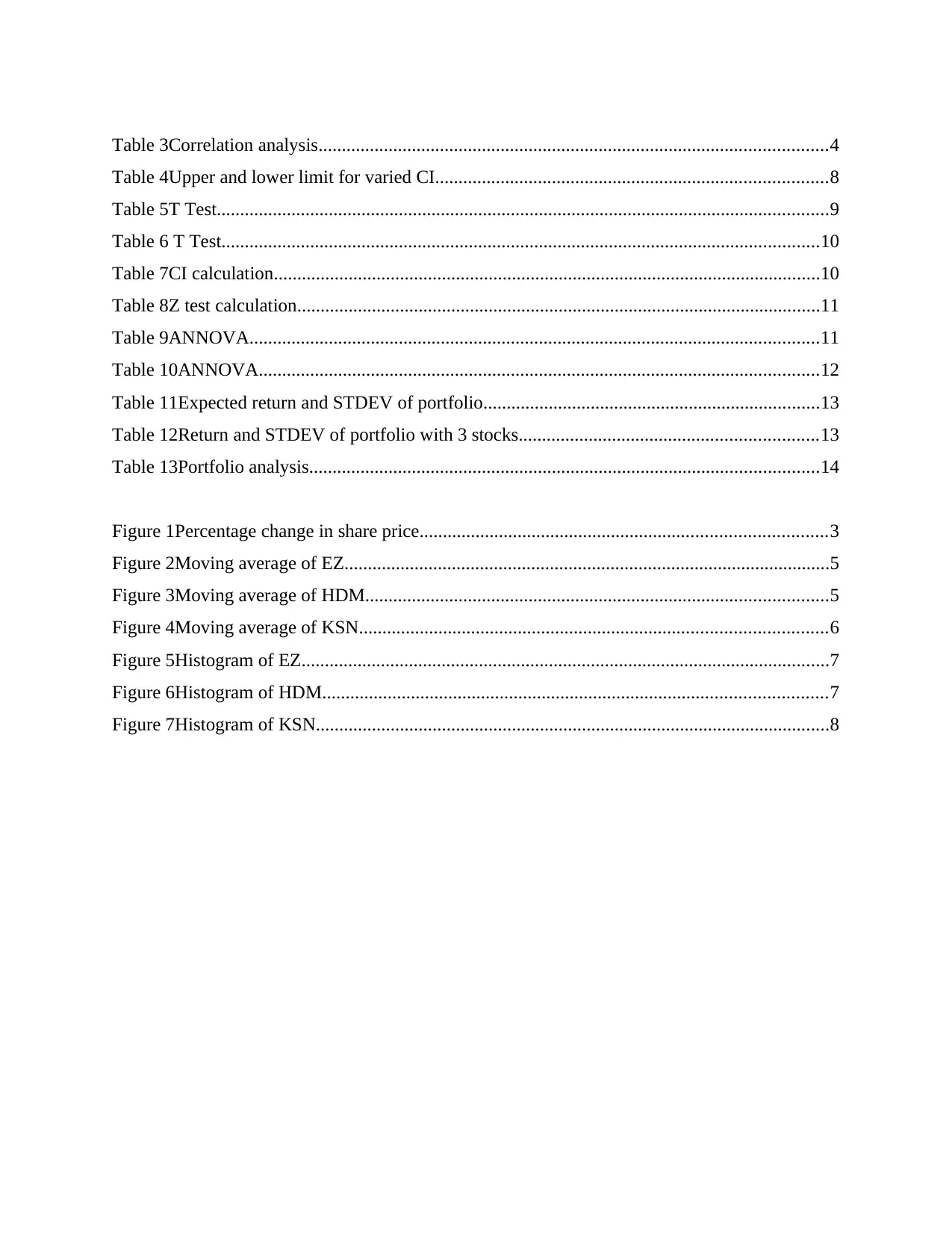
Table 3Correlation analysis.............................................................................................................4
Table 4Upper and lower limit for varied CI....................................................................................8
Table 5T Test...................................................................................................................................9
Table 6 T Test................................................................................................................................10
Table 7CI calculation.....................................................................................................................10
Table 8Z test calculation................................................................................................................11
Table 9ANNOVA..........................................................................................................................11
Table 10ANNOVA........................................................................................................................12
Table 11Expected return and STDEV of portfolio........................................................................13
Table 12Return and STDEV of portfolio with 3 stocks................................................................13
Table 13Portfolio analysis.............................................................................................................14
Figure 1Percentage change in share price.......................................................................................3
Figure 2Moving average of EZ........................................................................................................5
Figure 3Moving average of HDM...................................................................................................5
Figure 4Moving average of KSN....................................................................................................6
Figure 5Histogram of EZ.................................................................................................................7
Figure 6Histogram of HDM............................................................................................................7
Figure 7Histogram of KSN..............................................................................................................8
Table 4Upper and lower limit for varied CI....................................................................................8
Table 5T Test...................................................................................................................................9
Table 6 T Test................................................................................................................................10
Table 7CI calculation.....................................................................................................................10
Table 8Z test calculation................................................................................................................11
Table 9ANNOVA..........................................................................................................................11
Table 10ANNOVA........................................................................................................................12
Table 11Expected return and STDEV of portfolio........................................................................13
Table 12Return and STDEV of portfolio with 3 stocks................................................................13
Table 13Portfolio analysis.............................................................................................................14
Figure 1Percentage change in share price.......................................................................................3
Figure 2Moving average of EZ........................................................................................................5
Figure 3Moving average of HDM...................................................................................................5
Figure 4Moving average of KSN....................................................................................................6
Figure 5Histogram of EZ.................................................................................................................7
Figure 6Histogram of HDM............................................................................................................7
Figure 7Histogram of KSN..............................................................................................................8
Paraphrase This Document
Need a fresh take? Get an instant paraphrase of this document with our AI Paraphraser
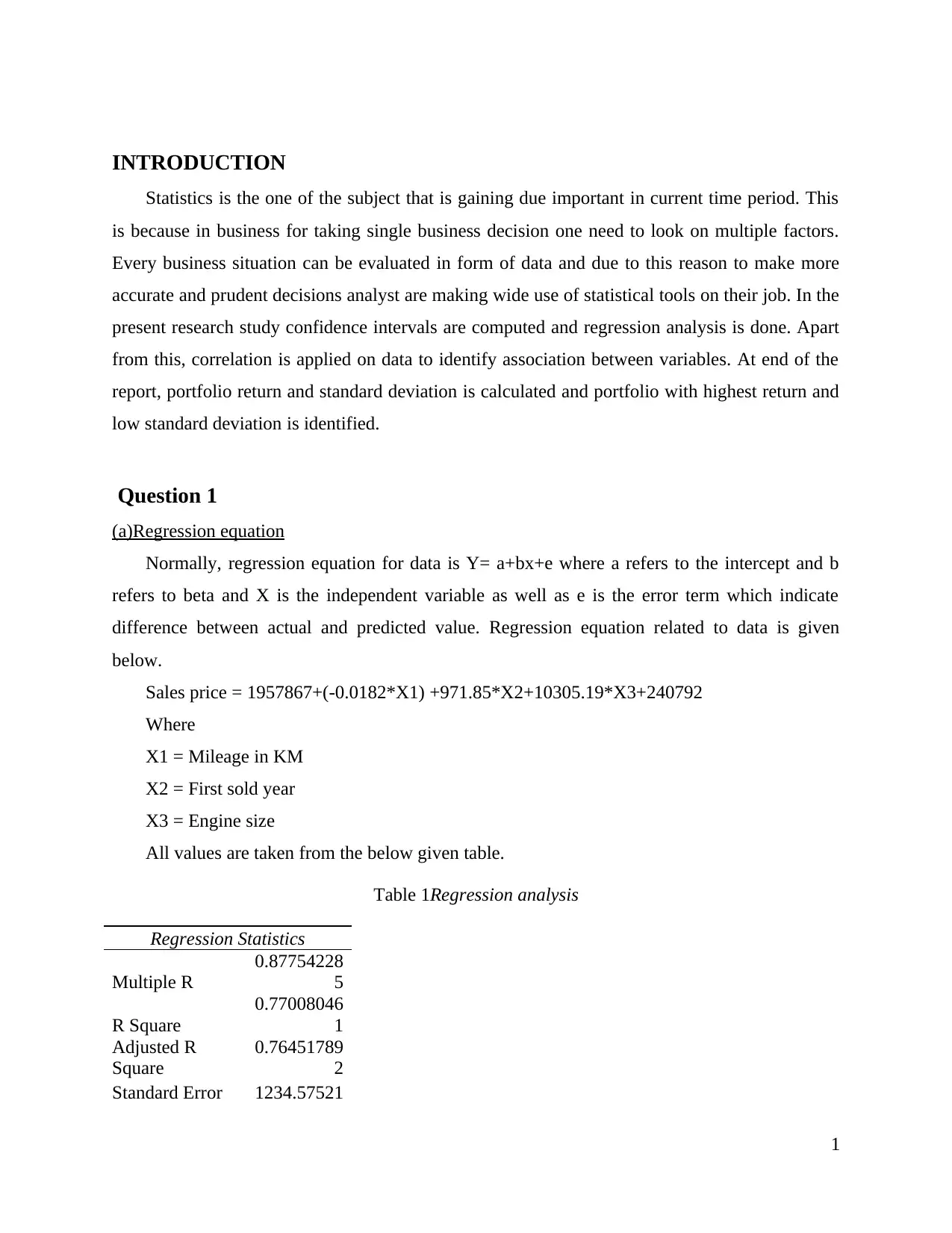
INTRODUCTION
Statistics is the one of the subject that is gaining due important in current time period. This
is because in business for taking single business decision one need to look on multiple factors.
Every business situation can be evaluated in form of data and due to this reason to make more
accurate and prudent decisions analyst are making wide use of statistical tools on their job. In the
present research study confidence intervals are computed and regression analysis is done. Apart
from this, correlation is applied on data to identify association between variables. At end of the
report, portfolio return and standard deviation is calculated and portfolio with highest return and
low standard deviation is identified.
Question 1
(a)Regression equation
Normally, regression equation for data is Y= a+bx+e where a refers to the intercept and b
refers to beta and X is the independent variable as well as e is the error term which indicate
difference between actual and predicted value. Regression equation related to data is given
below.
Sales price = 1957867+(-0.0182*X1) +971.85*X2+10305.19*X3+240792
Where
X1 = Mileage in KM
X2 = First sold year
X3 = Engine size
All values are taken from the below given table.
Table 1Regression analysis
Regression Statistics
Multiple R
0.87754228
5
R Square
0.77008046
1
Adjusted R
Square
0.76451789
2
Standard Error 1234.57521
1
Statistics is the one of the subject that is gaining due important in current time period. This
is because in business for taking single business decision one need to look on multiple factors.
Every business situation can be evaluated in form of data and due to this reason to make more
accurate and prudent decisions analyst are making wide use of statistical tools on their job. In the
present research study confidence intervals are computed and regression analysis is done. Apart
from this, correlation is applied on data to identify association between variables. At end of the
report, portfolio return and standard deviation is calculated and portfolio with highest return and
low standard deviation is identified.
Question 1
(a)Regression equation
Normally, regression equation for data is Y= a+bx+e where a refers to the intercept and b
refers to beta and X is the independent variable as well as e is the error term which indicate
difference between actual and predicted value. Regression equation related to data is given
below.
Sales price = 1957867+(-0.0182*X1) +971.85*X2+10305.19*X3+240792
Where
X1 = Mileage in KM
X2 = First sold year
X3 = Engine size
All values are taken from the below given table.
Table 1Regression analysis
Regression Statistics
Multiple R
0.87754228
5
R Square
0.77008046
1
Adjusted R
Square
0.76451789
2
Standard Error 1234.57521
1
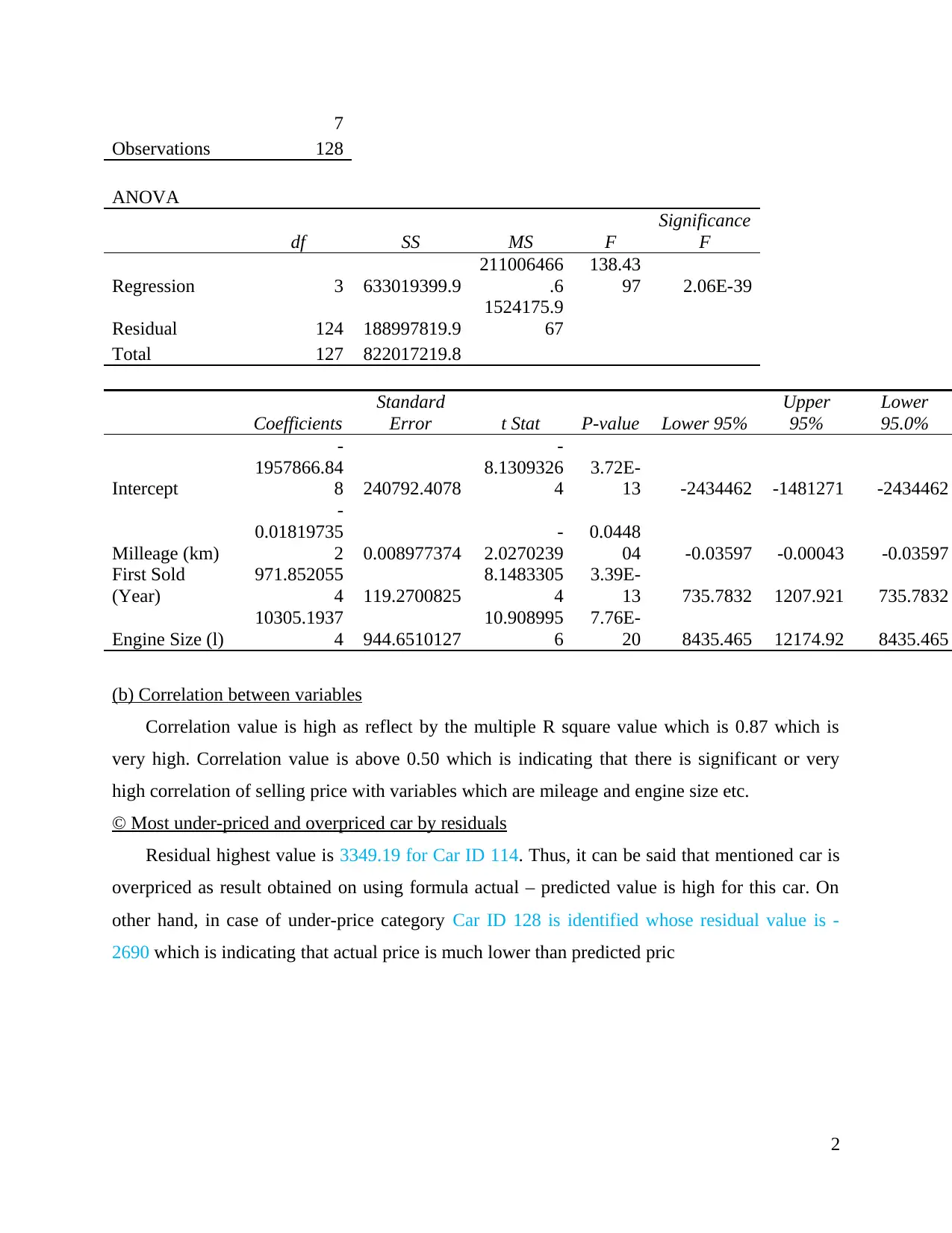
7
Observations 128
ANOVA
df SS MS F
Significance
F
Regression 3 633019399.9
211006466
.6
138.43
97 2.06E-39
Residual 124 188997819.9
1524175.9
67
Total 127 822017219.8
Coefficients
Standard
Error t Stat P-value Lower 95%
Upper
95%
Lower
95.0%
Intercept
-
1957866.84
8 240792.4078
-
8.1309326
4
3.72E-
13 -2434462 -1481271 -2434462
Milleage (km)
-
0.01819735
2 0.008977374
-
2.0270239
0.0448
04 -0.03597 -0.00043 -0.03597
First Sold
(Year)
971.852055
4 119.2700825
8.1483305
4
3.39E-
13 735.7832 1207.921 735.7832
Engine Size (l)
10305.1937
4 944.6510127
10.908995
6
7.76E-
20 8435.465 12174.92 8435.465
(b) Correlation between variables
Correlation value is high as reflect by the multiple R square value which is 0.87 which is
very high. Correlation value is above 0.50 which is indicating that there is significant or very
high correlation of selling price with variables which are mileage and engine size etc.
© Most under-priced and overpriced car by residuals
Residual highest value is 3349.19 for Car ID 114. Thus, it can be said that mentioned car is
overpriced as result obtained on using formula actual – predicted value is high for this car. On
other hand, in case of under-price category Car ID 128 is identified whose residual value is -
2690 which is indicating that actual price is much lower than predicted pric
2
Observations 128
ANOVA
df SS MS F
Significance
F
Regression 3 633019399.9
211006466
.6
138.43
97 2.06E-39
Residual 124 188997819.9
1524175.9
67
Total 127 822017219.8
Coefficients
Standard
Error t Stat P-value Lower 95%
Upper
95%
Lower
95.0%
Intercept
-
1957866.84
8 240792.4078
-
8.1309326
4
3.72E-
13 -2434462 -1481271 -2434462
Milleage (km)
-
0.01819735
2 0.008977374
-
2.0270239
0.0448
04 -0.03597 -0.00043 -0.03597
First Sold
(Year)
971.852055
4 119.2700825
8.1483305
4
3.39E-
13 735.7832 1207.921 735.7832
Engine Size (l)
10305.1937
4 944.6510127
10.908995
6
7.76E-
20 8435.465 12174.92 8435.465
(b) Correlation between variables
Correlation value is high as reflect by the multiple R square value which is 0.87 which is
very high. Correlation value is above 0.50 which is indicating that there is significant or very
high correlation of selling price with variables which are mileage and engine size etc.
© Most under-priced and overpriced car by residuals
Residual highest value is 3349.19 for Car ID 114. Thus, it can be said that mentioned car is
overpriced as result obtained on using formula actual – predicted value is high for this car. On
other hand, in case of under-price category Car ID 128 is identified whose residual value is -
2690 which is indicating that actual price is much lower than predicted pric
2
⊘ This is a preview!⊘
Do you want full access?
Subscribe today to unlock all pages.

Trusted by 1+ million students worldwide
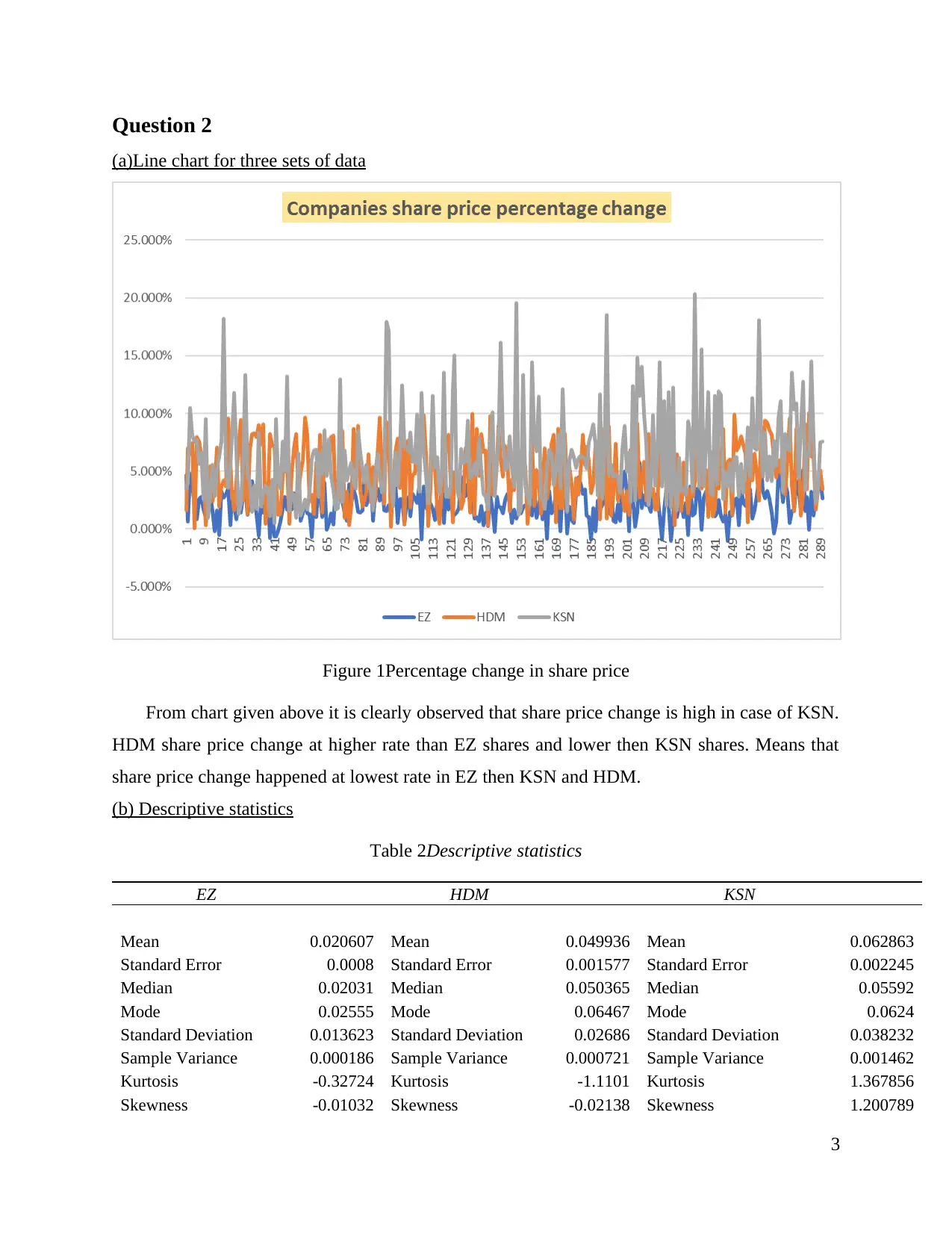
Question 2
(a)Line chart for three sets of data
Figure 1Percentage change in share price
From chart given above it is clearly observed that share price change is high in case of KSN.
HDM share price change at higher rate than EZ shares and lower then KSN shares. Means that
share price change happened at lowest rate in EZ then KSN and HDM.
(b) Descriptive statistics
Table 2Descriptive statistics
EZ HDM KSN
Mean 0.020607 Mean 0.049936 Mean 0.062863
Standard Error 0.0008 Standard Error 0.001577 Standard Error 0.002245
Median 0.02031 Median 0.050365 Median 0.05592
Mode 0.02555 Mode 0.06467 Mode 0.0624
Standard Deviation 0.013623 Standard Deviation 0.02686 Standard Deviation 0.038232
Sample Variance 0.000186 Sample Variance 0.000721 Sample Variance 0.001462
Kurtosis -0.32724 Kurtosis -1.1101 Kurtosis 1.367856
Skewness -0.01032 Skewness -0.02138 Skewness 1.200789
3
(a)Line chart for three sets of data
Figure 1Percentage change in share price
From chart given above it is clearly observed that share price change is high in case of KSN.
HDM share price change at higher rate than EZ shares and lower then KSN shares. Means that
share price change happened at lowest rate in EZ then KSN and HDM.
(b) Descriptive statistics
Table 2Descriptive statistics
EZ HDM KSN
Mean 0.020607 Mean 0.049936 Mean 0.062863
Standard Error 0.0008 Standard Error 0.001577 Standard Error 0.002245
Median 0.02031 Median 0.050365 Median 0.05592
Mode 0.02555 Mode 0.06467 Mode 0.0624
Standard Deviation 0.013623 Standard Deviation 0.02686 Standard Deviation 0.038232
Sample Variance 0.000186 Sample Variance 0.000721 Sample Variance 0.001462
Kurtosis -0.32724 Kurtosis -1.1101 Kurtosis 1.367856
Skewness -0.01032 Skewness -0.02138 Skewness 1.200789
3
Paraphrase This Document
Need a fresh take? Get an instant paraphrase of this document with our AI Paraphraser
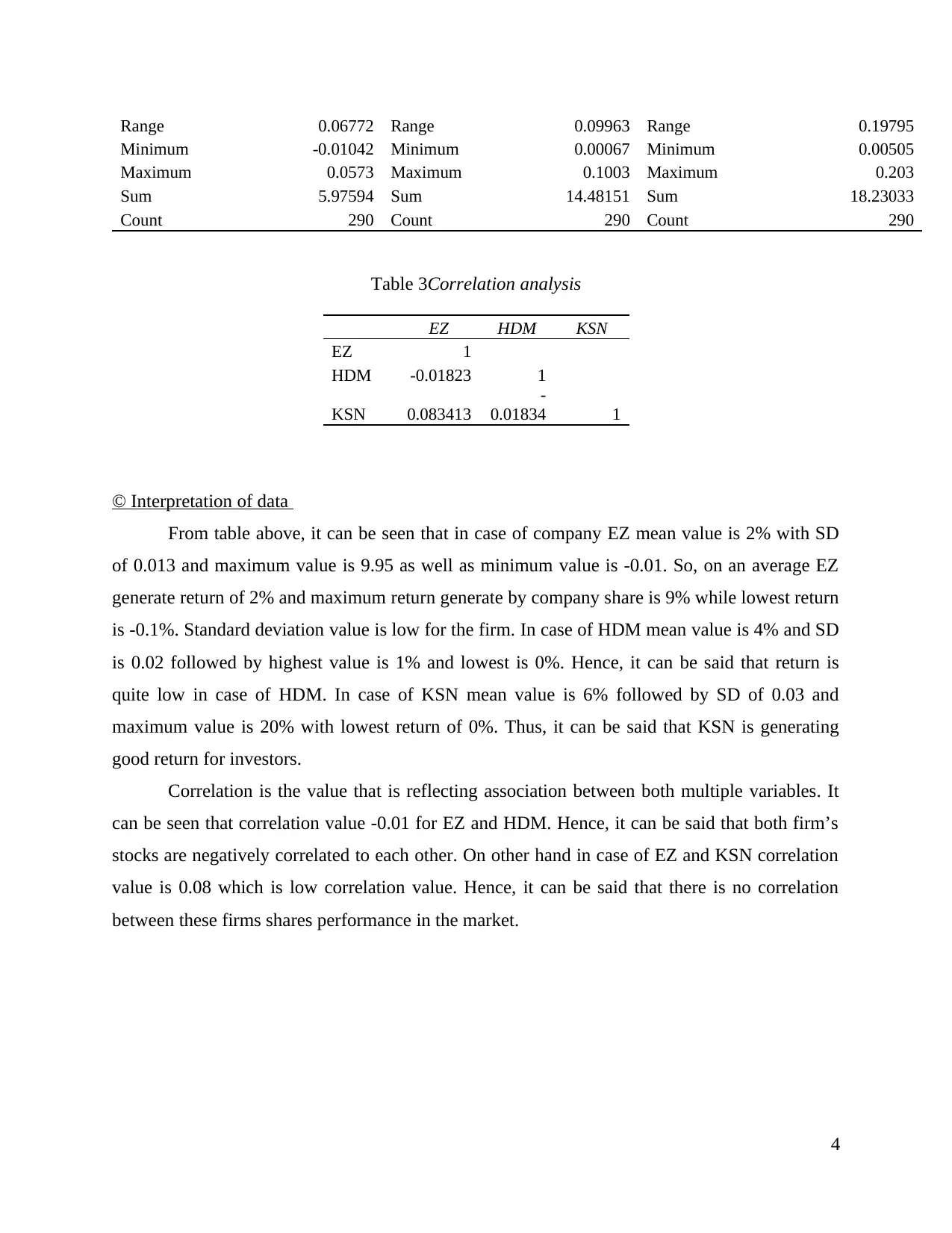
Range 0.06772 Range 0.09963 Range 0.19795
Minimum -0.01042 Minimum 0.00067 Minimum 0.00505
Maximum 0.0573 Maximum 0.1003 Maximum 0.203
Sum 5.97594 Sum 14.48151 Sum 18.23033
Count 290 Count 290 Count 290
Table 3Correlation analysis
EZ HDM KSN
EZ 1
HDM -0.01823 1
KSN 0.083413
-
0.01834 1
© Interpretation of data
From table above, it can be seen that in case of company EZ mean value is 2% with SD
of 0.013 and maximum value is 9.95 as well as minimum value is -0.01. So, on an average EZ
generate return of 2% and maximum return generate by company share is 9% while lowest return
is -0.1%. Standard deviation value is low for the firm. In case of HDM mean value is 4% and SD
is 0.02 followed by highest value is 1% and lowest is 0%. Hence, it can be said that return is
quite low in case of HDM. In case of KSN mean value is 6% followed by SD of 0.03 and
maximum value is 20% with lowest return of 0%. Thus, it can be said that KSN is generating
good return for investors.
Correlation is the value that is reflecting association between both multiple variables. It
can be seen that correlation value -0.01 for EZ and HDM. Hence, it can be said that both firm’s
stocks are negatively correlated to each other. On other hand in case of EZ and KSN correlation
value is 0.08 which is low correlation value. Hence, it can be said that there is no correlation
between these firms shares performance in the market.
4
Minimum -0.01042 Minimum 0.00067 Minimum 0.00505
Maximum 0.0573 Maximum 0.1003 Maximum 0.203
Sum 5.97594 Sum 14.48151 Sum 18.23033
Count 290 Count 290 Count 290
Table 3Correlation analysis
EZ HDM KSN
EZ 1
HDM -0.01823 1
KSN 0.083413
-
0.01834 1
© Interpretation of data
From table above, it can be seen that in case of company EZ mean value is 2% with SD
of 0.013 and maximum value is 9.95 as well as minimum value is -0.01. So, on an average EZ
generate return of 2% and maximum return generate by company share is 9% while lowest return
is -0.1%. Standard deviation value is low for the firm. In case of HDM mean value is 4% and SD
is 0.02 followed by highest value is 1% and lowest is 0%. Hence, it can be said that return is
quite low in case of HDM. In case of KSN mean value is 6% followed by SD of 0.03 and
maximum value is 20% with lowest return of 0%. Thus, it can be said that KSN is generating
good return for investors.
Correlation is the value that is reflecting association between both multiple variables. It
can be seen that correlation value -0.01 for EZ and HDM. Hence, it can be said that both firm’s
stocks are negatively correlated to each other. On other hand in case of EZ and KSN correlation
value is 0.08 which is low correlation value. Hence, it can be said that there is no correlation
between these firms shares performance in the market.
4
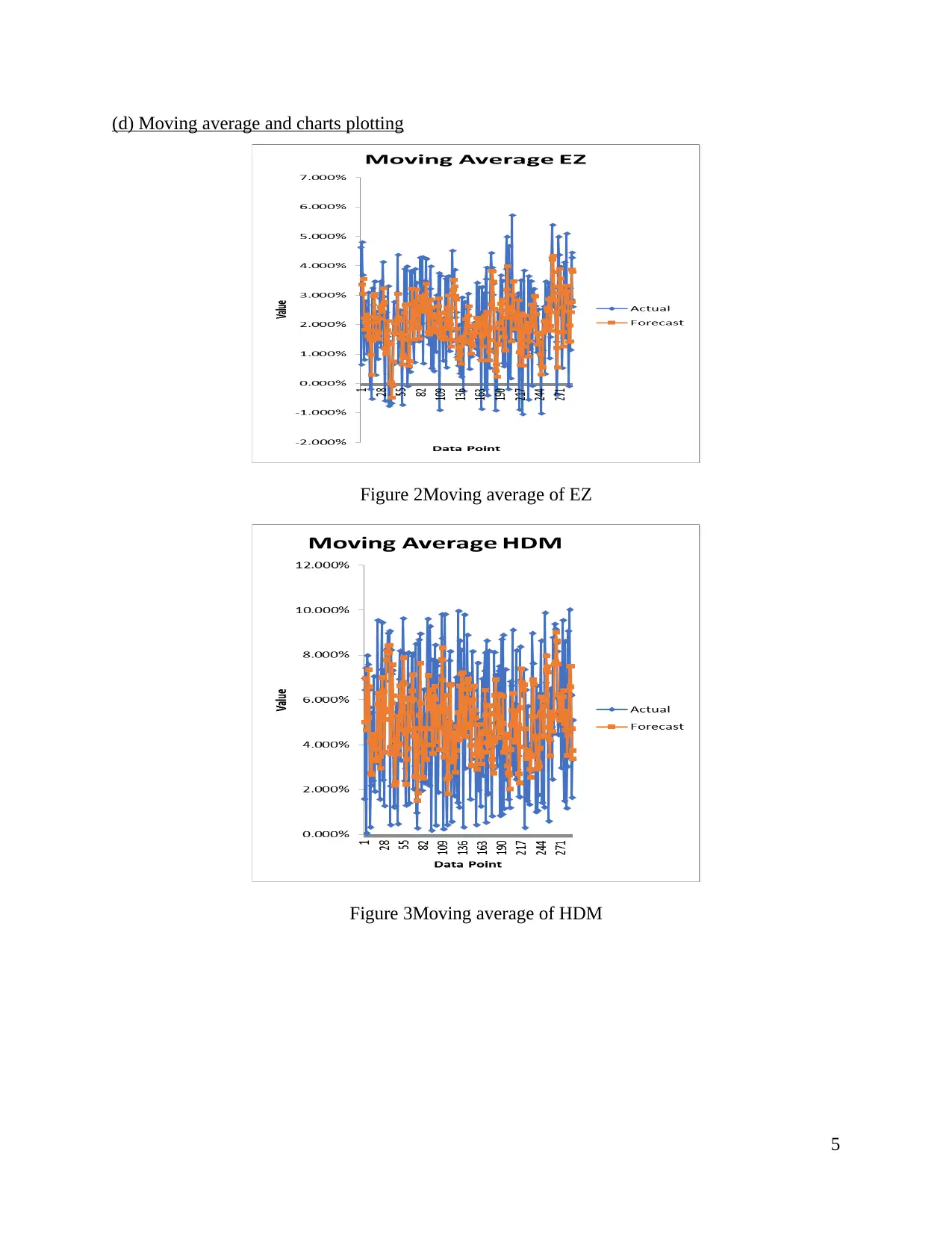
(d) Moving average and charts plotting
Figure 2Moving average of EZ
Figure 3Moving average of HDM
5
Figure 2Moving average of EZ
Figure 3Moving average of HDM
5
⊘ This is a preview!⊘
Do you want full access?
Subscribe today to unlock all pages.

Trusted by 1+ million students worldwide
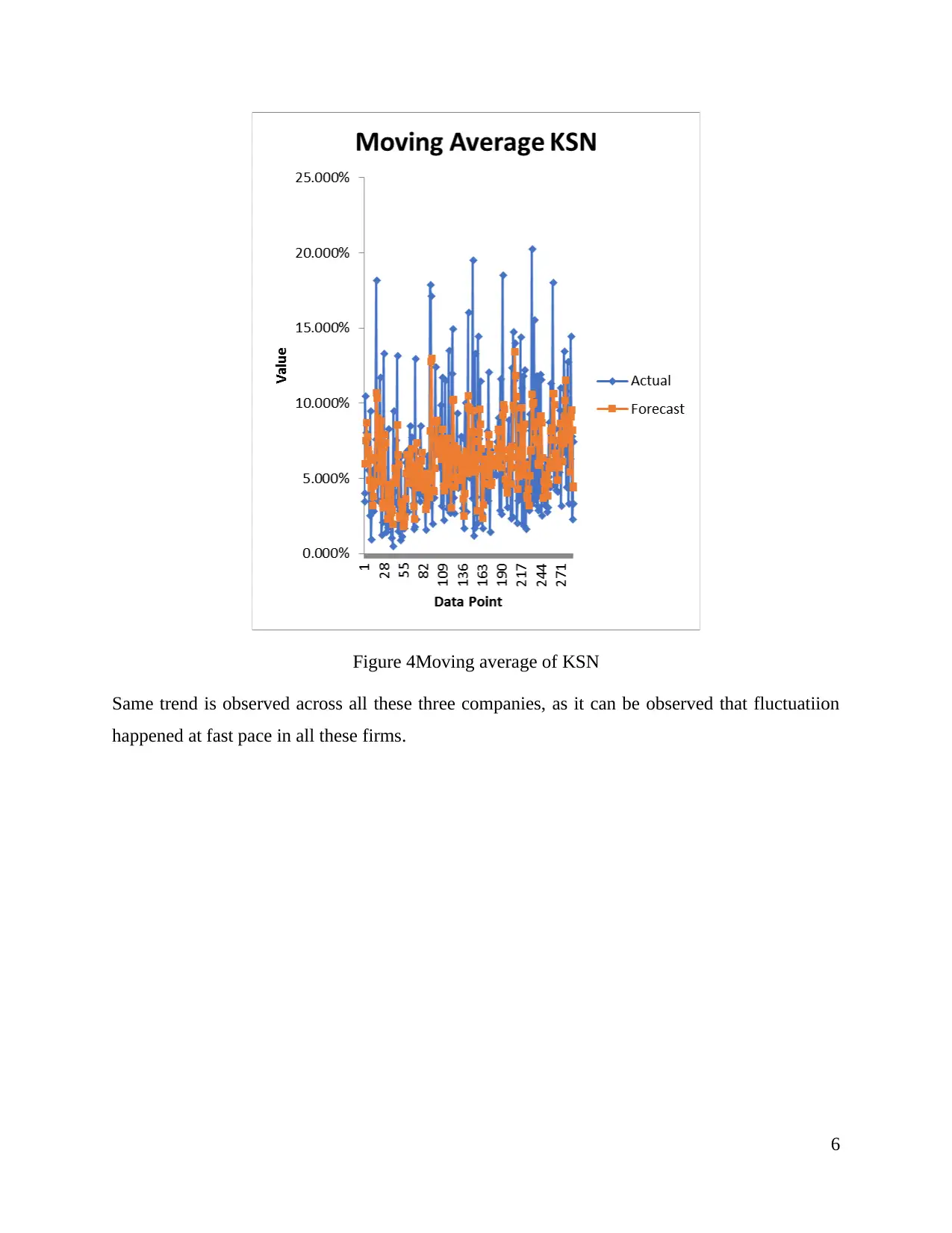
Figure 4Moving average of KSN
Same trend is observed across all these three companies, as it can be observed that fluctuatiion
happened at fast pace in all these firms.
6
Same trend is observed across all these three companies, as it can be observed that fluctuatiion
happened at fast pace in all these firms.
6
Paraphrase This Document
Need a fresh take? Get an instant paraphrase of this document with our AI Paraphraser
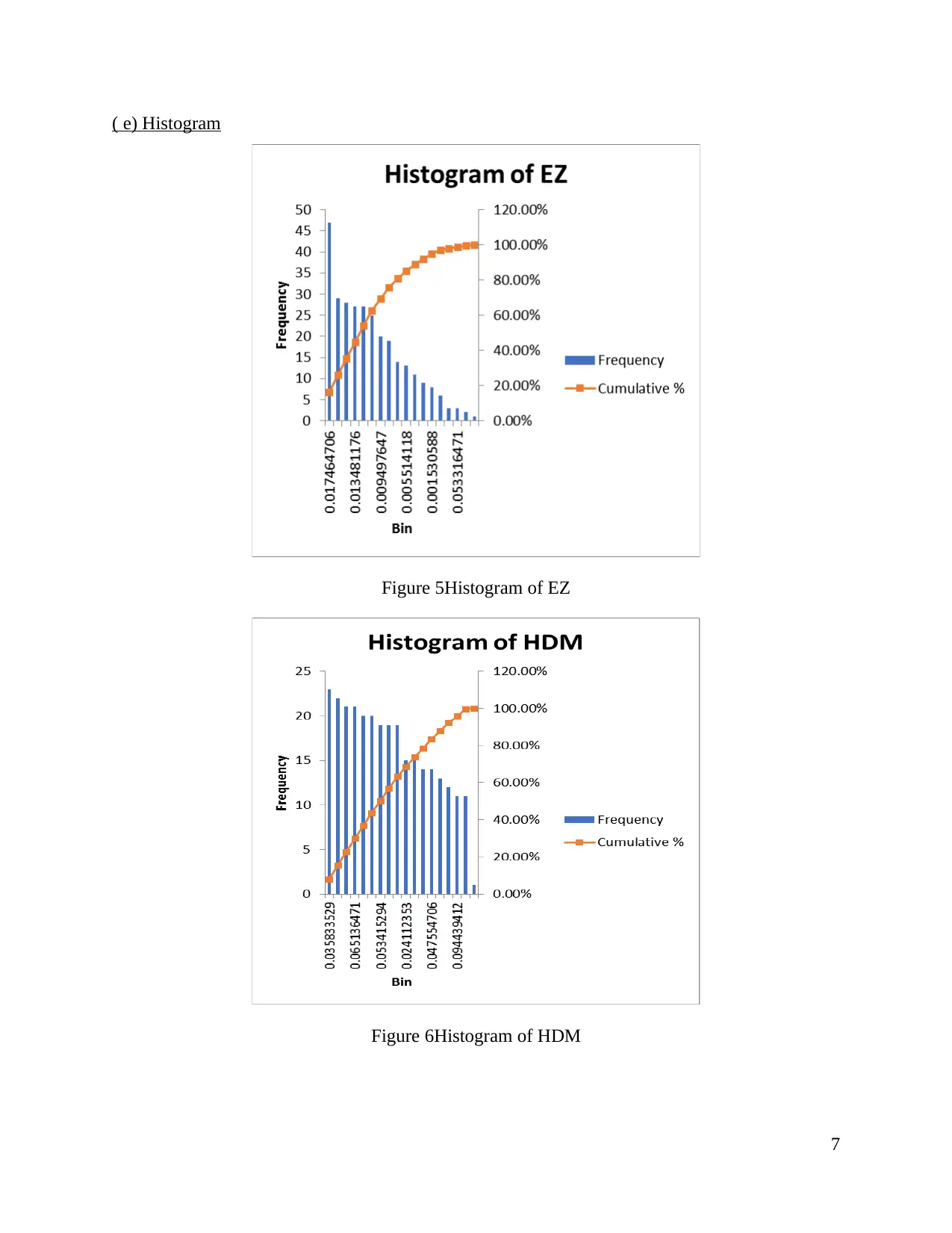
( e) Histogram
Figure 5Histogram of EZ
Figure 6Histogram of HDM
7
Figure 5Histogram of EZ
Figure 6Histogram of HDM
7
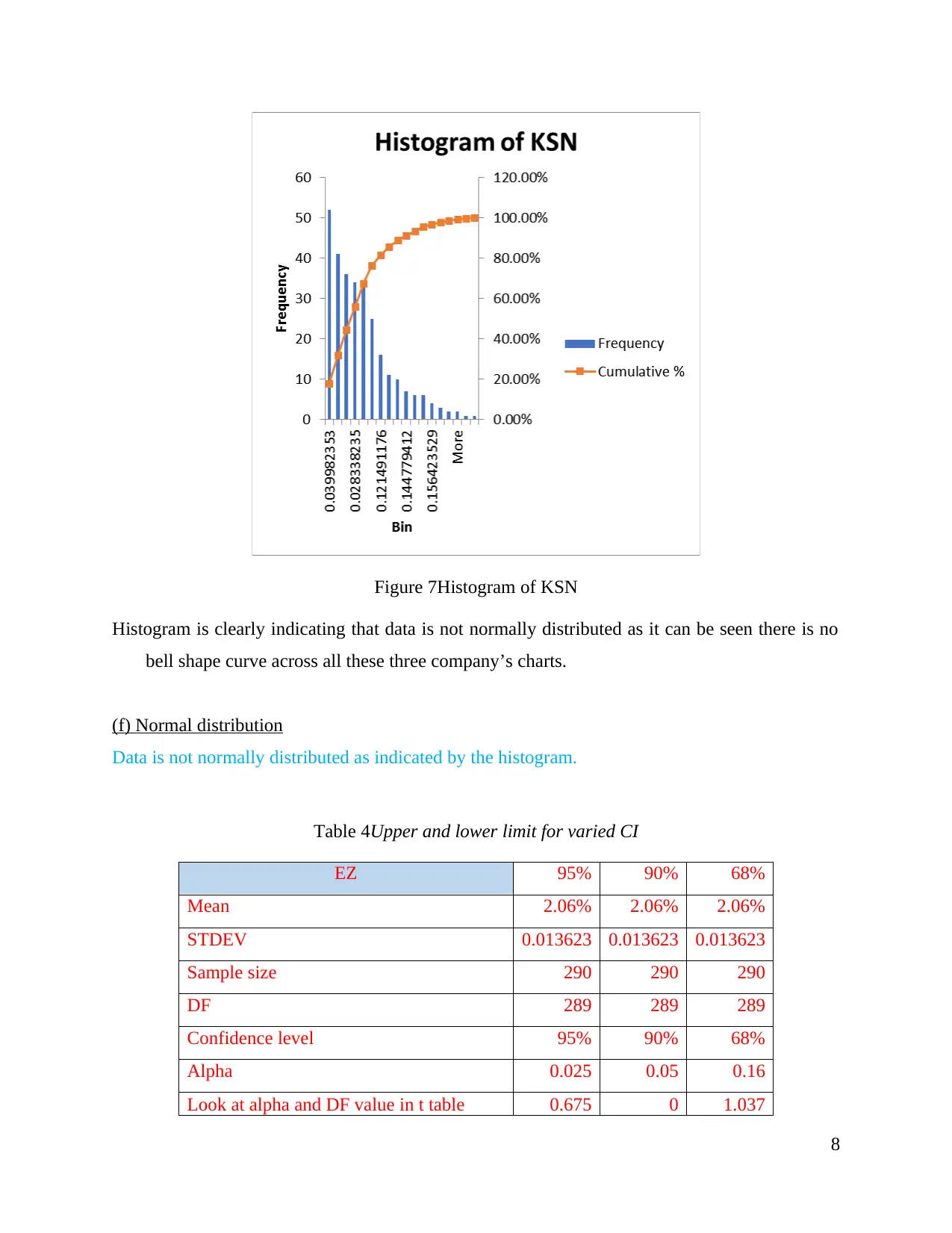
Figure 7Histogram of KSN
Histogram is clearly indicating that data is not normally distributed as it can be seen there is no
bell shape curve across all these three company’s charts.
(f) Normal distribution
Data is not normally distributed as indicated by the histogram.
Table 4Upper and lower limit for varied CI
EZ 95% 90% 68%
Mean 2.06% 2.06% 2.06%
STDEV 0.013623 0.013623 0.013623
Sample size 290 290 290
DF 289 289 289
Confidence level 95% 90% 68%
Alpha 0.025 0.05 0.16
Look at alpha and DF value in t table 0.675 0 1.037
8
Histogram is clearly indicating that data is not normally distributed as it can be seen there is no
bell shape curve across all these three company’s charts.
(f) Normal distribution
Data is not normally distributed as indicated by the histogram.
Table 4Upper and lower limit for varied CI
EZ 95% 90% 68%
Mean 2.06% 2.06% 2.06%
STDEV 0.013623 0.013623 0.013623
Sample size 290 290 290
DF 289 289 289
Confidence level 95% 90% 68%
Alpha 0.025 0.05 0.16
Look at alpha and DF value in t table 0.675 0 1.037
8
⊘ This is a preview!⊘
Do you want full access?
Subscribe today to unlock all pages.

Trusted by 1+ million students worldwide
1 out of 23
Related Documents
Your All-in-One AI-Powered Toolkit for Academic Success.
+13062052269
info@desklib.com
Available 24*7 on WhatsApp / Email
![[object Object]](/_next/static/media/star-bottom.7253800d.svg)
Unlock your academic potential
Copyright © 2020–2025 A2Z Services. All Rights Reserved. Developed and managed by ZUCOL.





